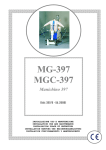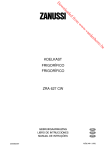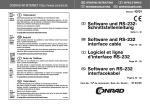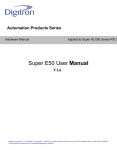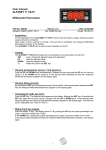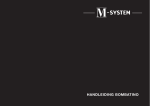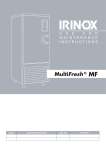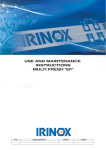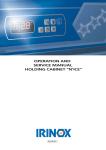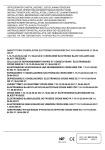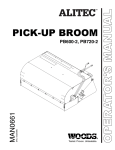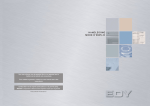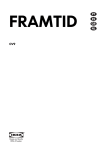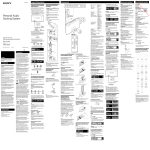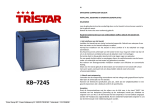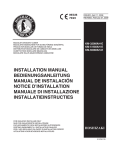Download "service manual"
Transcript
OPERATION AND SERVICE MANUAL SERIE "HC" serie LC e HC Guarantee and service information Phone numbers: Customer service Assistance for use of chiller Technical assistance - spare parts Fax E-mail Web site +39.0438.5844 +39.0438.5844 +39.0438.584271 +39.0438.5843 [email protected] www.irinox.com For any request concerning your chiller, always provide the model and the serial number shown on the following dataplate: Dear customer, We wish to thank you for the trust you have shown us by choosing an IRINOX chiller, and we ask you to carefully read the manual which will provide you with all the necessary information to immediately start chilling your products. We do in any case suggest that you study this manual so as to take advantage of all the potential and benefits that your IRINOX chiller has to offer. Proper operation of the machine also depends on its proper use. Keep this manual near your chiller, so that it can easily be consulted by you and your operators. Good work with IRINOX! Subscribe online to Club Irinox : www.irinox.com The graphic representation of the commands in this manual makes it easier to understand the operations to be performed, so that you can immediately start satisfactorily using your IRINOX LOGIK CHILL chiller. Symbols legend suggestions and details for correct use of the chiller instructions for your safety additional information in this manual Algemene instructies 1.1 Introductie De plaatsing mag uitsluitend door geautoriseerde specialisten worden uitgevoerd met inachtneming van de instructies in deze handleiding. Indien de machine wordt uitgerust met een separate condensor unit is het aansluiten en in werking stellen van de machine de verantwoording van de installateur. Het garantie certificaat welke u in de documentatie vindt moet gelezen, ingevuld en ondertekend worden door de installateur en klant en worden teruggestuurd aan de fabrikant anders zal deze als ongeldig worden beschouwd. 1.2Veiligheids instructies Om onderhoud en schoonmaak veilig uit te kunnen voeren dienen de volgende veilheids instructies in acht te worden genomen: • raak de machine niet met natte of vochtige handen of voeten aan • werk niet blootsvoets aan de machine • stop geen gereedschap, keukengerei of andere voorwerpen tussen de roosters of bewegende onderdelen • sluit voor schoonmaak of onderhoudswerkzaamheden de machine af van de voeding door de machine uit te zetten en de stekker uit het contact te halen • trek niet aan de voedingsdraad om de stekker uit het contact te verwijderen 1.2.1 Beveiliging voor het laden leegmaken van de machine en Beladen: Gebruik bij het beladen van de machine ovenwanten om verbranding aan hete potten en pannen te voorkomen Leeg maken: • Open de deur voorzichtig na afloop van een koel of vriescyclus tot de ventilator stil staat • Verwijder de kerntemperatuurmeter uit het product en plaats hem in de houder • Gebruik passende handschoenen voor koude pannen en schalen 1.2.2 Pas op voor scherpe kernvoeler Gebruik van de voeler is uitsluitend toegestaan voor personeel dat voor het gebruik van de chiller is geschoold. De voeler mag alleen gebruikt worden voor het doel waarvoor het is ontworpen: meting van temperaturen in de kern van producten die moeten worden gekoeld of ingevroren. Ben voorzichtig met de voeler, de punt is scherp om deze makkelijker in het product te stoppen. De ergonomische greep maakt het eenvoudig de voeler te plaatsen of te verwijderen. 1.2.3 Let op de verwarmde kernvoeler Gebruik de voelerverwarming uitsluitend wanneer deze in een bevroren product is geplaatst. Raak om gevaar voor verbranding te voorkomen de voeler punt niet aan na gebruik van de verwarmingsfunctie. 1.2.4 Gebruik van de UV-lamp De sterilisatiefunctie met UV lampen(optioneel) mag alleen worden gebruikt voor de reden waarvoor deze is ontworpen: sterilisatie van de wanden van de koelkamer. Langdurige blootstelling aan de brandende UV lampen kan oogirritatie veroorzaken. 1.2.5 Periodieke personeelstraining Instrueer alle medewerkers die met de machine werken regelmatig ivm de veiligheidsmaatregelen. Wijs uw medewerkers op deze handleiding en bewaar hem op een voor iedereen bekende plaats in de buurt van de machine om ongelukken te voorkomen. 1.3 Beladen van de machine Voorkom dat schalen of pannen met deksels of folie worden afgedekt. Hoe meer oppervlak van het product in contact komt met de koude lucht hoe sneller het product afkoelt. Gebruik zo ondiep mogelijke pannen en schalen, in ieder geval niet dieper als 6,5 cm. Voor het beste resultaat raden wij aan de schalen te vullen met maximaal 3,5 kg product met een maximale dikte van 8 cm voor koelen of cm voor vriezen. Gebruik voor moeilijke of vette producten zelfs dunnere lagen. Let erop dat er genoeg ruimte tussen de schalen is zodat genoeg lucht tussen de schalen kan circuleren. Spreidt wanneer de machine niet volledig wordt beladen de schalen over de gehele koelkamer. Plaats de schalen in het midden van de kamer en zorg ervoor dat deze midden voor de ventilator staan. Plaats bij trolley gebruik de trolley midden in de koelruimte. Belaad de machine niet boven de grenzen aangegeven door de fabrikant. 1.3.1 Voorkoelen Het is belangrijk de machine bij een koel of vriescyclus voor te koelen om de koeltijd te verkorten. Start daarvoor een Hard of Soft chill cyclus in de manuele stand voordat de machine wordt beladen. Om schade aan de machine te voorkomen mogen geen warme producten in de machine blijven staan. Start een koel- of vriescyclus direct nadat het warme product in de machine is geplaatst. 1.3.2 Kerntemperatuurmeter (voeler) De voeler dient goed in het midden van het product te worden gestoken, zorg ervoor dat de punt niet uitsteekt of de schaal raakt. Om ongewenste besmetting te voorkomen moet de voelerpunt voor ieder cyclus goed worden gereinigd. Voor het beste resultaat raden wij aan de schalen te vullen met maximaal 3,5 kg product met een maximale dikte van 8 cm voor koelen of 5 cm voor vriezen. Gebruik voor moeilijke of vette producten zelfs dunnere lagen. 1.3.3 Temperaturen Vermijdt om producten die moeten worden gekoeld of ingevroren voor langere periode bij kamertemperatuur te laten staan. Hoe meer vocht verloren gaat hoe meer schade het product ondervindt. Het is aan te raden de producten die gekoeld of ingevroren moeten worden direct na de bereiding terug te koelen, bij voorkeur met een temperatuur boven +70C. Bereide producten kunnen zelfs met een zeer hoge temperatuur (>100C) direct in de voorgekoelde chiller worden geplaatst. Houdt er echter rekening mee dat de referentietijd begint bij +90C (van +90C tot +3C bij snelkoeling; van +90C tot -18C bij invriezen). 1.3.4 Conservering Gekoeld en ingevroren moet goed worden afgedekt en beschermd (met folie, deksel of door vakuum) en worden voorzien van een label met vermelding van de inhoud, productiedatum en vermoedelijke houdbaarheidsdatum. Teruggekoeld voedsel moet worden bewaard in een gekoelde ruimte met een konstante temperatuur van +2C. Ingevroren voedsel moet worden bewaard in een gekoelde ruimte met een konstante temperatuur van -20C. Gebruik de chiller niet als bewaar koel- of vrieskast. 2.Omschrijving van de controlepanelen A= B= C= D= E= F= G= H= I= L= M= N= O= P= Q= R= Aan/uit schakelaar SOFT chill cyclus keuzeknop HARD cyclus keuzeknop Snelvries cyclus keuzeknop Automatische cyclus (kerntemperatuur gestuurd) Handmatige cyclus (tijd gestuurd) Cyclus start/stop knop Luchttemperatuur uitlezing Tijd en kerntemperatuur uitlezing Knoppen voor het handmatig bewerken van de tijdinstelling Tijdweergave Kerntemperatuurweergave Ontdooi knop Sterilisatie cyclus knop (UV) Voeler verwarming Printen van cycli uit het geheugen 2.1 Omschrijving van de koelprogramma’s *”SOFT”chilling Dit programma zorgt voor een snelle terugkoeling tot +3C waarbij de koeltemperatuur schommelt tussen 0C en +2C (in ieder geval nooit onder 0C) binnen 90 minuten. Deze cyclus is bijzonder geschikt voor delicate producten zoals; mousses, puddings, cremes, deserts, groentes en etenswaren van geringe dikte. *”HARD”chilling Dit programma zorgt voor een snelle terugkoeling tot +3C waarbij de koeltemperatuur schommelt tussen 15C en +2C. Deze cyclus zorgt voor een aanzienlijk verkorte terugkoeltijd en is zeer geschikt voor producten met een hoog vetgehalte, hoge dichtheid, grote stukken of verpakte producten. *SHOCK FREEZING Met deze cyclus wordt de kerntemperatuur tot -18C teruggebracht met een luchttemperatuur die tot -35/40C kan dalen. Dit moet worden bereikt binnen 4 uur, maar de lengte van dit programma is sterk afhankelijk van het type voedsel, de dikte, starttemperatuur, verpakking etc. *CONSERVERING Aan het einde van een koel (bij een kerntemperatuur van +3C) of vriescyclus bij een kerntemperatuur van 18C) schakelt de machine automatisch over op een bewaarstand met een kostante luchtstroom van +2C of -20C. Deze fase stopt pas wanneer deze door een gebruiker wordt beëindigd. Het wordt afgeraden de apparatuur als bewaarkoeling te gebruiken of de deur regelmatig te openen en sluiten gedurende deze fase. De bewaarstand is bedoeld als tijdelijke fase tussen het koelen of vriezen en de conserveerfase in een geschikte koeling. 2.1.1 Beschrijving van de overige funkties *Ontdooien (uitsluitend op machine typen H en C) Deze functie kan door de gebruiker gekozen worden om eventuele ijsvorming op de condensor in de koelruimte te verwijderen. Zet de deur open en start de ontdooiing, deze stopt automatisch na 30 minuten. De ventilator zuigt warme lucht vanuit de productieruimte naar binnen en ontdooit zo snel het aanwezige ijs. Waarschuwing: deze functie is niet geschikt om bevroren voedingsmiddelen te ontdooien. *Sterilisatie (optioneel) De UV lampen zorgen voor een microbiologische reactie en steriliseren de oppervlakken, vloeistoffen en lucht in de koelkamer. Het is een zelfstandige functie en kan alleen uitgevoerd worden als geen andere cycly in gang zijn. Een sterilisatie cyclus duurt 30 minuten. De optimale temperatuur voor desinfectie ligt tussen +20C en +40C. Gedurende de cyclus is het mogelijk keuken gerei te steriliseren door deze in de koelkamer te leggen. Voor de veiligheid zal de lamp 4 seconden na opening van de deur automatisch uitgaan, zodra deze wordt gesloten wordt de cyclus weer opgestart. Wij adviseren u deze functie aan het einde van een werkdag na reiniging van de machine en aan het begin van een koelperiode te gebruiken. *Verwarming van de kerntemperatuurmeter (uitsluitend op machine typen H en C) De (gepatenteerde) verwarmingsfunctie van de punt van de kerntemperatuurmeter wordt gebruikt om deze makkelijk uit bevroren producten te verwijderen. *Printer Data betreffende tijd, temperaturen en alarmen van iedere koel of vriescyclus kunnen worden uitgeprint via een ingebouwde printer (optioneel) of met een losse printer die op het controle paneel kan worden aangesloten. 2.2 AUTOMATIC MODE In de Automatische mode wordt de controle van de koel- en vriescycli beheerst door middel van de kerntemperatuurmeter in combinatie met het elektronische paneel dat de kerntemperatuur van het product registreerd. De temperatuur van de luchtstroming in de kamer ziet u op het “air temp” display , de temperatuur van de kern van het product op het “core temp” display. Zodra de ingestelde temperatuur van het product is bereikt geeft de machine dit aan door middel van een korte zoemtoon, de machine schakelt automatisch over in de bewaarstand wat wordt aangegeven door een groen knipperende cyclus indicator. Om de verstreken tijd te bekijken drukt u op de tijdweergave knop, in het “time”display ziet u de verstreken tijd. 2.4 MANUAL MODE In de Manual (handmatige) mode wordt de controle van de koel- en vriescycli beheerst door middel van de timer die de lengte van de cyclus in minuten regelt. De koellucht temperatuur wordt beheerst door de temperatuurmeter in de koelkamer. De benodigde tijd voor de betreffende cyclus wordt getoond op het “timer” display, weergegeven in uren en minuten terwijl de koelkamer temperatuur op het “air temp” display wordt getoond. Na verstrijken van de ingestelde tijd geeft de machine het einde van de cyclus aan door middel van een zoemtoon, de machine schakelt automatisch over in de bewaarstand wat wordt aangegeven door een groen knipperende cyclus indicator. Gedurende de Manual cyclus kunt u de temperatuur van de kerntemperatuurmeter bekijken door op de kerntemperatuurweergave te drukken, op het “core temp”display kunt u deze uitlezen. Deze temperatuur heeft nu geen invloed op het verloop van de koel- of vriescyclus. 2.4.1 TIJD instelling Duur van de koel- en vriestijd in de Manual mode. De tijd de is ingesteld om de cyclus te voltooien kan worden aangepast. U kunt de tijd aanpassen met behulp van de + en – knoppen. Hiervoor moet u eerst een Manual cyclus starten. Zolang het indicatielampje (W1) brandt kan de knop worden gebruikt, als deze uitgaat moet opnieuw op de tijdweergave knop worden gedrukt. 2.5 Temperatuurvoelers Iedere chiller bevat twee temperatuurmeters, een vast in de koelkamer en een verplaatsbare in de vorm van een voeler om de temperatuur in de kern van het product te registreren. In de modellen HCM en HCC is in de punt van de kernvoeler een element geplaatst om verwijdering uit een bevroren product te vergemakkelijken. Druk de voeler verwarmingsknop, wacht tot de groene led boven deze knop uitgaat en verwijder de voeler uit het product. Beveiliging om onnodige verhitting van de voeler te voorkomen: • zorg dat geen cyclus bezig is • open de deur • de kerntemperatuur moet onder de 0C zijn • verhit niet langer als 5 seconden NB: herhaal deze handeling indien noodzakelijk na minimaal 1 minuut wachttijd. 2.5.1 KERNVOELERS controle module (optioneel- nier verkrijgbaar op modellen LC51.25 en LC101.35) Hiermee is het mogelijk 3 kernvoelers gelijktijdig in de chiller te gebruiken. De temperatuur in het display refereert naar de voeler aangegeven door de led S/1, S/2 of S/3. Om de temperatuur van de andere voelers af te lezen drukt u de kerntemperatuurweergaveknop. 2.5 TEMPERATUUR uitlezing De temperatuur van de koelluchtvoeler wordt constant getoond in het “air temp” display (behalve gedurende sterilisatie en ontdooiing cycli). De temperatuur gemeten door de kerntemperatuurvoeler ziet u in het “core temp” display gedurende cycli in de Automatic stand. Gedurende de Manual cyclus kunt u de temperatuur van de kerntemperatuurmeter bekijken door op de kerntemperatuurweergave te drukken, op het “core temp”display kunt u deze uitlezen. De voeler werkt nu als gewone temperatuurmeter en heeft geen invloed op het verloop van de koel- of vriescyclus. 2.6 De machine aan en uit zetten Het bedieningspaneel is ontworpen om u op eenvoudige manier te leiden bij het instellen van een koel- of vriescyclus . Dit wordt ondersteund door middel van knipperende LED’s Start de machine door de ON knop te drukken. In de displays vindt u de actuele lucht- en kerntemperatuur. Kies een koel of de vriescyclus Start de cyclus door de START knop te drukken. De start van het programma wordt aangegeven door het groen oplichten van de indicator. Om de cyclus te stoppen druk STOP. Zet de machine uit met de OFF knop. 2.7 NOODSTOP In noodgeval *druk de OFF knop om de machine te stoppen *onderbreek de stroomvoorziening In het geval dat de stroomvoorziening tijdens een cyclus wordt onderbroken zal na herstel hiervan de machine verder gaan met de cyclus die tijdens de onderbreking draaide. 3.BEDIENINGS VOORBEELDEN 3.1 KOEL EN VRIES PROGRAMMA’S Kies een van de programma’s waarbij de knoppen blauw oplichten: SOFT snelkoeling HARD snelkoeling HARDPLUS snelkoeling (tweemaal drukken) SHOCK FREEZING snelvriezen Kies AUTOMATIC of MANUAL Wanneer u Automatic heeft gekozen drukt u de kernvoeler midden in het product en drukt u START (als aangegeven in het tekstdisplay) om de machine te starten. Wanneer u Manual heeft gekozen drukt u START (als aangegeven in het tekstdisplay) om de machine te starten. Door START te drukken zal de indicator groen oplichten als teken dat de cyclus goed verloopt. Aan het einde van de cyclus gaat de machine automatisch over op de bewaarstand, de groene indicator zal gaan knipperen, tot de STOP knop wordt gedrukt. 3.2 PARAMETER PROGRAMMERING 3.2.1 Gebruiker parameters Zet de machine uit met de OFF knop en trek de stekker uit het stopkontakt om gebruikergegevens te wijzigen, Druk nu de kernvoelerknop en tijdknop tegelijk in terwijl u de spanning hersteld tot de PrO boodschap in het AIR TEMP display en --in het TIME display verschijnt. Laat nu de kernvoelerknop en tijdknop los en gebruik deze om de code van de te bewerken parameter te selecteren in het AIR TEMP display (zie onderstaande lijst). In het TIME display wordt de huidige waarde van de parameters getoond die kunnen worden aangepast met de + en – knop. Druk START/STOP om de programmering te beëindigen. 3.2.2 PARAMETER INSTELLINGEN Het is mogelijk de waarden van de standaard ingestelde parameters voor koel- of vriescycli aan te passen aan uw wensen of specifieke producten. Zet de machine aan met de ON knop, druk gelijktijdig de CORE PROBE en TIMER knop en houdt deze vijf seconden vast tot PrO in het AIR TEMP display en --- in het TIMER display verschijnt, kies de cyclus waarvan u de instellingen wilt aanpassen dan de AUTOMATIC of MANUAL knop gebruik de kernvoelerknop en tijdknop om de code van de te bewerken parameter te selecteren in het AIR TEMP display (zie onderstaande lijst). In het TIME display wordt de huidige waarde van de parameters getoond die kunnen worden aangepast met de + en – knop Druk START/STOP om de programmering te beëindigen. List of cycle set parameters: Set of cycles inMANUALmode SOFT 1st set = chilling air temperature 2nd set= conservation air temperature DEFAULT RANGE -20 ÷+ 20 °C -10 ÷+ 10 °C 1 ÷8 h min -1°C +2 °C 1st set = HARD air temperature 2nd set = air temperature 3rd set S1 conservation air temperature = 4th set HARD phase time = 5th set SOFT phase time = SHOCK FREEZING -40 ÷+ 10 °C set n°1 ÷+ 20 °C -20 °C -1 °C set n°3 ÷+ 10 °C +2 °C 1 min. ÷8 h 30 min. 1 min ÷8 h 1h 1st set = freezing air temperature 2nd set = conservation air temperature 3rd = freezing time set -60 ÷-20 °C set n°1 ÷0 °C -40°C -20 °C 1 min. ÷8 h 4h 1 min. ÷4 h 30 min. 1st set = cycle time 1 min. ÷2 h 30 min. Set of cycles inAUTOMATICmode RANGE LOGIK CHILL 1st set = balancing air temperature 2nd set =cycle end core temperature -5 ÷+ 5 °C 0 ÷+ 20 °C +2 °C (do not touch) +3 °C SOFT 1st set = cycle end core temperature 2nd set = SOFT chilling air temperature 3rd set = conservation air temperature -10 ÷+ 30 °C -20 ÷+ 20 °C set n°2÷+ 20 °C +3 °C -1 °C +2 °C 1st set = end of HARD phase core temperature 2nd set = cycle end core temperature 3rd set = HARD chilling air temperature 4th set = SOFT chilling air temperature 5th set = conservation air temperature -10 ÷+ 40 °C -10 °C ÷set n°1 -60 ÷+ 10 °C set n°3 ÷+ 20 °C set n°4 ÷+ 20 °C +20 °C +3 °C -20 °C -1 °C +2 °C SHOCK FREEZING 1st set = cycle end core temperature 2nd set = conservation air temperature 3nd set = freezing air temperature -40 ÷+ 2 °C -40 ÷+ 2 °C -60 ÷set n°2 -18 °C -20 °C -40 °C 3rd set = chilling time 1 h 30 min. HARD UV 1st set = cycle time DEFROSTING DEFAULT HARD 3.3 PRINTERS Gedurende de gehele koel- en vriescycli worden gegevens van de kerntemperatuurmeter, luchttemperatuurmeter en het tijdverloop als volgt opgeslagen: • tijd en datum van de programma start • storingen • eindtijd van de cyclus • geselecteerde tijdinterval • bij de keuze van CONSERVATION in de cyclus opname elke 15 minuten de bewaargegevens I zie Parameter programmering par. 3.2. Wanneer er een alarm optreedt tijdens een cyclus wordt deze geregistreerd met tijd en storinggegevens en op de afdruk uitgeprint. De OPEN DOOR melding wordt alleen geregistreerd als de deur langer als de door de fabrikant ingestelde tijd (parameter 5) van 5 minuten open staat. Wanneer de CONSERVATION opname is gekozen worden de gegevens na de cyclus iedere 15 minuten geregistreerd, na afloop van de cyclus wordt de volgende melding geprint: END CONS. CYCLE datum en tijd Deze gegevens kunnen met een portabelprinter (optioneel), welke op het controle paneel met een seriële poort kan worden aangesloten, uitgeprint worden. Uitprinten Sluit de externe printer aan op de seriele poort van de chiller. Printen is alleen mogelijk wanneer de machine in de stand-by stand staat zonder dat een cyclus loopt. Druk de PRINT knop om alle opgeslagen cycli af te drukken, beginnend met de laatst opgeslagen cyclus. Tijdens het printen zal Prn in het tijddisplay verschijnen. NB: om het printen te stoppen drukt u 5 sec. op PRINT, het afdrukken stopt dan aan het einde van de uitgeprinte cyclus. Het geheugen van het controle paneel heeft voldoende capaciteit om 500 printregels op te slaan . Als de buffer vol is worden de oudste data overschreven. Om alle opgeslagen gegevens te wissen drukt u + en – tegelijkertijd, het TIME display zal rEP aangeven. In bijzondere gevallen wordt de opname cyclus gestopt en het probleem uitgeprint: Recording stopped; Power off Recording stopped: Machine Block Machine stopped: Clock error 4. ALGEMEEN ONDERHOUD De informatie in dit hoofdstuk is voor iedereen wie met de machine in aanraking komt, de gebruiker, service medewerker en zelfs niet getrainde medewerkers. 4.1 Basis veiligheids instructies Om schoonmaak en algemene onderhoudswerkzaamheden aan de machine te verrichten moet u rekening houden met de volgende basis regels: • raak de machine niet met natte of vochtige handen of voeten aan • werk niet blootsvoets aan de machine • stop geen gereedschap, keukengerei of andere voorwerpen tussen de roosters of bewegende onderdelen • sluit voor schoonmaak of onderhoudswerkzaamheden de machine af van de voeding door de machine uit te zetten en de stekker uit het contact te halen • trek niet aan de voedingsdraad om de stekker uit het contact te verwijderen Het is streng verboden roosters en andere veiligheids voorzieningen te verwijderen voor dagelijks onderhoud. De fabrikant heeft geen verantwoordelijkheid voor ongelukken veroorzaakt door het niet navolgen van deze instructie. Voor de machine gebruikt wordt is het nodig de koelkamer grondig te reinigen zoals in de volgende paragraaf beschreven. 4.2 Reinigen van de koelkamer Om hygiëne te garanderen en de kwaliteit van de producten te beschermen, dient de koelruimte na iedere werkdag grondig te worden gereinigd. Door de vorm van de ruimte en de keuze van de componenten zijn deze eenvoudig te reinigen met een zachte doek of spons. Gebruik water en neutrale, niet agressieve schoonmaakmidden. De koelruimte kan worden uitgesopt met een doek of spons, of eventueel met water uitgespoten worden (met een druk niet hoger als de normale leidingwaterdruk). !! Gebruik geen scherpe voorwerpen of schrapers. !! Gebruik geen agressieveschoonmakmiddelen. 4.2.1 Sterilisatie cyclus (optioneel) Wij adviseren u deze functie aan het einde van een werkdag na reiniging van de machine en aan het begin van een koelperiode te gebruiken. 4.2.2 Verdamper reiniging !! Gebruik altijd beschermende handschoenen tijdens de volgende handelingen. Hoe de verdamper te bereiken: Door de schroeven aan de linkerzijde van de ventilatordeur los te draaien krijgt u toegang tot de verdamper. Schoonmaak van de verdamper; Om de verdamper te reinigen kunt u een zachte borstel gebruiken en deze voorzichtig in verticale richting tussen de aluminium panelen te bewegen. Sluit na afloop de ventilatordeur en draai de schroeven weer vast. !! Gebruik nooit scherpe voorwerpen! 4.2.3 Condensatie water Modellen met een ingebouwde compressor zijn voorzien van een kunststof opvangbak die onder de machine wordt geschoven. Deze zal regelmatig moeten worden geleegd. 4.3 Condensor reiniging Om de chiller goed en efficiënt te laten werken is het belangrijk dat de condensor schoon is en goede luchtgeleiding mogelijk is. Bereiken van de condensor: Bij modellen met een ingebouwde compressor kunt u de condensor aan de voorzijde bereiken, het beschermingsrooster verwijderd u door de schroeven aan de onderzijde te verwijdern en het paneel weg te nemen. U kunt de condensor met een zachte borstel of met een stofzuiger reinigen en daarna het paneel weer terugplaatsen. Bij modellen met een separate compressor kunt u het beschermingsrooster verwijderen door het iets op te lichten en dan naar voren af te nemen !! Gebruik altijd veiligheidshandschoenen, bril en masker om u te beschermen. Hoe de condensor te reinigen: De condensor moet minimaal iedere 30 dagen worden gereinigd. Dit kan gedaan worden door met een zachte borstel alle stof en troep van de condensor panelen te los te vegen. Daarna kunt u dit het beste verwijderen met behulp van een stofzuiger. Als er vetresten op de condensor zijn kunnen deze het beste met een wattenstaafje met alcohol worden verwijderd. !! Schraap het oppervlak nooit al met harde of agressieve middelen. 4.4 Alarmsignalen en probleemoplossing De alarmsignalen van de chiller kunnen in drie categorieën worden ingedeeld: Machine STOP alarm Deze categorie wordt veroorzaakt door veiligheidssystemen die gebruik van de machine blokkeren. Om de machine te gebruiken moet u: • de oorzaak van de melding verhelpen • het controlepaneel aan en uitschakelen om het alarm af te zetten NB: bij dit soort alarm kan het nodig zijn een service monteur te hulp te roepen. Display alarm met handmatige reset. Dit soort alarm vereist de tussenkomst van een gebruiker die na de oorzaak gevonden en opgelost te hebben het alarmsignaal kan stoppen zodat de machine weer normaal kan gestart kan worden. Druk START/STOP Display alarm met automatische reset. Deze categorie alarmen zijn verbonden aan veiligheidsvoorzieningen die zodra de normale werkomstandigheden zijn hersteld zichzelf opheffen en de machine de cyclus normaal laten beëindigen. Het is echter belangrijk de oorzaak van het alarm zo snel mogelijk te traceren zodat het kan worden verholpen. NB: Wanneer de oorzaak van een dergelijk alarm niet wordt verholpen zal deze melding terugkomen zodra de machine weer wordt gestart. Alle alarmen worden aangegeven door een rood knipperende indicator en een zoemer, en door een code, die in de TIME en AIR TEMP display worden weergegeven. De tabellen op de volgende pagina’s laten mogelijke oorzaken die een alarm kunnen veroorzaken, in volgorde van waarschijnlijkheid, zowel als de voorgestelde oplossing. 4.4.1 Lijst met alarmcodes die de machine blokkeren ALARM CODE MOGELIJKE OORZAAK ALC Thermische uitschakeling van de compressor “compressor” Defecte thermische beveiliging van de compressor Ontbreken van 24V op de transformator uitgang Geen 24V tussen verbinding NR 23 en NR 24 Defecte compressor Defecte electronica APF “fan panel” Ventilatordeur in de koelkamer staat open Verkeerde positie van de magneet deurschakelaar Defecte deur microschakelaar Defecte electronica AS1 Defecte temperatuurmeter “temperatuurmeter” blok alarm alleen in de Defecte verbinding AUTOMATIC mode in de MANUAL mode Defecte print wordt deze vervangen door de kerntemperatuurmeter OPLOSSING Check de electrische aansluiting en de fases op L1,L2,L3 en N Controleer de aansluiting van de thermische beveiliging van de compressor Controleer de voeding en werking van de transformator Controleer de zekering op de 2e 24V van de transformator Vervang de compressor Controleer de CPU print door een jumper te maken tussen kabel NR 24 en verbinding NR 4 van het M5 verbindingsblok.Als het alarm aanhoud moet de print vervangen worden. Sluit de deur en draai de schroeven aan de linkerzijde aan Zet de schakelaar op de juiste plaats goed vast Controleer de schakelaar en vervang deze indien nodig Controleer de CPU print door een jumper te maken tussen kabel NR 24 en verbinding NR 2 van het M5 verbindingsblok.Als het alarm aanhoud moet de print vervangen worden. Vervang de meter Controleer de aansluitingen op het controle paneel Vervang de print Lijst met alarcodes met een handmatige reset (START/STOP) ALARM CODE AS2 “kerntemperatuurmete r” AL3 “Standaard instellingen opnemen” MOGELIJKE OORZAAK Defecte kerntemperatuurmeter Defecte verbinding Defecte print Machine stelt verandere instelingen OPLOSSING Vervang de kerntemperatuurmeter Controleer de aansluiting op het controle paneel Vervang de print zich in na Druk de START/STOP knop en dip-swith wacht tot de data zijn geladen Lijst met alarmcodes met automatische reset. ALARM CODE ALP “Hoge druk” MOGELIJKE OORZAAK Hoge druk veiligheids onderbreking Onvoldoende compressor capaciteit Onvoldoende ventilatie Hete lucht circulatie bij de compressor d-o “deur open” Defecte print Koelkamer deur staat open Verkeerde positie van de magneet deurschakelaar Defecte deur microschakelaar Defecte electronica d-c “deur gesloten” AL1 AL2 AL5 AL6 Gesloten deur Verkeerde positie van de magneet deurschakelaar Defecte deur microschakelaar Verbindingsfout tussen de stuur print en de hoofdprint Defecte print Verbindingsfout tussen de stuur print en de PC Defecte print Koelkamer temperatuur komt boven de +40C tijdens een vriescyclus Tijd module of batterij werk niet OPLOSSING Controleer de werkdruk oorzaak van de onderbreking Reinig de condensor unit en Controleer de werking en juiste draairichting van de ventilatoren Controleer de luchtstrooming rond de compressor en verplaats deze zonodig Vervang de print Sluit de deur Zet de schakelaar op de juiste plaats goed vast Controleer de schakelaar en vervang deze indien nodig Controleer de CPU print door een jumper te maken tussen kabel NR 24 en verbinding NR 3 van het M5 verbindingsblok.Als het alarm aanhoud moet de print vervangen worden. Open de deur Zet de schakelaar op de juiste plaats goed vast Controleer de schakelaar en vervang deze indien nodig Controleer de verbinding Vervang de print Herstel de verbinding Vervang de print Controleer de reden van de oververhitting Controleer de print. Als het alarm aanhoud de print vervangen 4.5 VERVANGEN VAN UITWISSELBARE ONDERDELEN 4.5.1 VERVANGING VAN DE KERNVOELER Indien het nodig is de kernvoeler te vervangen (alarm AS2) ga dan als volgt te werk: Van model HC 51.25 tot HC 142.80 1. Zet de machine uit en trek de stekker uit het stopcontact 2. Verwijder de schroeven van het ventilator paneel en draai de deur open 3. De zwarte verbinding is nu links zichtbaar 4. Draai de zwarte ring van de verbinding helemaal los 5. Maak de rubberen kabelbescherming links van het paneel los 6. Verwijder deze van de oude kabel, doe hem om de nieuwe en plaats hem weer terug 7. Steek de verbindingsstekker in de houder en draai de ring weer vast 8. Sluit de ventilator deur en draai de schroeven vast 9. Steek de stekker in het stopcontact en de machine is weer bedrijfsklaar Van model HC 102.80 tot HC 602.750 1. Zet de machine uit en schakel de voeding uit 2. Links van de verdamper ziet u het verbindingscontact 3. Draai de zwarte ring van de verbinding helemaal los 4. Steek de verbindingsstekker in de houder en draai de ring weer vast 5. Schakel de voeding in en de machine is weer bedrijfsklaar 4.5.2 VERVANGING VAN EEN DEURRUBBER Indien het nodig is een deurrubber te vervangen ga dan als volgt te werk: 1. 2. 3. 4. 5. 6. 7. 8. Zet de machine uit en schakel de voeding uit Open de deur Trek een hoek van het rubber uit de geleiding in de deur Trek voorzichtig het hele rubber uit de deur Druk het nieuwe rubber in de geleiding beginnend met de boven hoeken Controleer de juiste aansluiting in de geleiding langs de gehele deur Sluit de deur Schakel de voeding in en de machine is weer bedrijfsklaar 5. INSTALLATION INSTRUCTIONS The contents of this chapter is intended for authorised and specialised personnel and they are obliged to follow theseinstructions. The manufacturer declines any responsibility for possible damage caused by the use of non-original spare parts or of parts that are not specific for the model and for repairs or installations carried out by unauthorised personnel. 5.1 TRANSPORT AND HANDLING • • • Loading and unloading the appliance from vehicles can be effected using lift trucks or fork lifts trucks having a length exceeding half of the chiller, or by means of a crane if it is supplied with eyebolts. The hoisting apparatus must be suitably chosen on the basis of the size and mass of the packaged machine as indicated on the package label (“Weights and volume” table). All necessary precautions must be followed when handling the chiller to prevent damage to it and the instructions on the package must be respected. For models with an integrated condenser unit handling in a non-vertical position is not recommended (e.g. on its back). If this is necessary to wait at least 4 hours before switching the chiller on. 4h "Weights and volumes" table HC 51/20 HC 101/35 HC 141/50 HC 101/50 SR HC 142/70 HC 102/70 HC 122/100 HC 201/100 HC 201/90 ST HC 201/90 SR HC 202/100 HC 202/120 ST HC 202/150 HC 202/180 ST HC 202/250 HC 202/300 HC 402/300 HC 402/500 HC 602/450 HC 602/750 CARDBOARD PACKAGING / CRATE NET WEIGHT Kg W H D m3 Kg 103 215 270 270 365 475 260 340 340 340 410 380 480 450 510 550 820 920 1160 1300 740 850 880 950 950 1.430 1.430 2.530 2.530 2.530 2.470 2.530 2.470 2.530 2.470 2.630 2.850 2.850 4.050 4.050 750 890 1.000 1.120 1.120 1.460 1.460 1.445 1.445 1.285 1.675 1.675 1.675 1.995 1.825 2.105 2.595 2.595 2.595 2.595 1.020 1.720 2.100 2.100 2.100 2.180 1.710 1.190 1.190 1.190 1.325 1.350 1.325 1.350 1.515 1.715 1.700 1.700 1.700 1.700 0,6 1,3 1,8 2,2 2,2 4,6 3,6 4,4 4,4 3,9 5,5 5,7 5.5 6,8 6.8 9,5 12,6 12,6 17,9 17,9 130 240 300 300 395 550 410 440 440 440 530 500 600 560 650 700 1000 1150 1450 1600 29 I N S TA L L AT I O N INSTRUCTIONS MODELS 5 5.2 UNPACKING • • • Remove the cardboard or wooden packaging or box from the wooden base on which the machine is standing, lift the machine using suitable equipment (lift truck), remove the wooden base and stand the machine in the chosen place (see “positioning” paragraph). Check the condition of the chiller after having removed the packaging. Remove the protective PVC film from all sides. Use protective gloves to handle the packing and the wooden base. N.B.: all the various parts of the packaging must be disposed of according to the rules of the various Countries in which the chiller will be used. In any case, none of the packaging must be left in the environment. OFF!! 5.3 BASIC SAFETY INSTRUCTIONS If the instructions in this manual are not followed, the user takes upon himself responsibility of any operations carried out on the machine. These are the general safety rules: • do not touch the machine with damp or wet hands or feet; • do not operate the machine with bare feet; • do not insert screwdrivers, kitchen utensils or other objects between the guards or the moving parts; • before cleaning or carrying out ordinary maintenance, disconnect the machine from the mains by switching off the main switch and taking out the plug; • do not pull at the cable to unplug the machine. R 5.4 DATAPLATE DATA 31010 CORBANESE (TV) ITAY N • • ...... CLASS N Check that the dataplate data and the electric power supply characteristics correspond (V, kW, Hz, n° phases and available power). The dataplate bearing the specifications of the machine is on the RH side of the chiller. S-HERMETIC dm3 1375 L.P.kPa 993 R 404 A Hz 50 kW 1,5 A 4 IP44 WEIGHT g H.P.kPa 2.250 V 400V 3N ~ rated load 65 kg 30 M. HC..... COMPRESSOR REFRIGERANT 5.5 CELL POSITIONING 5.5.1 Models with integrated condenser unit Locate the units in the chosen place, after having unpacked them and removed the protective film and then follow the instructions below: Safety rules: • The machine must be installed and tested by fully respecting the accident-prevention standards, traditional rules and the Laws in force. • The installer must check for any fire-prevention rules (consult the local fire brigade headquarters for instructions). Places to avoid: • Places exposed to direct sunlight or any other source of heat. • Closed rooms with a high temperature and poor air circulation (for further information see: “Minimum air circulation” table). sp doace or to o pe 10 cm n 10 cm Minimum distances to be respected: • • • Maintain a minimum distance of 10 cm from the air inlet and outlet sides, not only to ensure optimum functioning of the machine, but also to allow enough space for maintenance. Leave a space of at least 3 cm from other refrigeration equipment to prevent formation of condensation on external surfaces. Make sure that it is possible to open the door. Move any obstacles away from the chiller in order to leave sufficient space around it for this purpose. I N S TA L L AT I O N INSTRUCTIONS Final levelling: • Level the appliance by means of the adjustable feet. Use special hoisting apparatus for the heaviest machine. If the chillers are not levelled, their proper functioning and the downflow of condensation may be jeopordized. 5.5.3 Positioning of remote condensing 5 31 5.5.2 Models with remote condensing units Place the appliances in the chosen location after having unpacked them and removed the protective film and follow the instructions below: Safety rules: • The machine must be installed and tested by fully respecting the accident-prevention standards, traditional precautions and the laws in force. • The installer must check for any fire-prevention rules (consult the local fire brigade headquarters for instructions). Places to avoid: • Places exposed to direct sunlight or any other source of heat. • Closed rooms with a high temperature and poor air circulation (for further information see par. 5.5 and “Minimum air circulation” table). Minimum distances to be respected: • Maintain a minimum distance of 10 cm from the air inlet and outlet sides, not only to ensure optimum functioning of the machine, but also to allow enough space for maintenance. • Leave a space of at least 3 cm from other refrigeration equipment to prevent formation of condensation on external surfaces. • Make sure that it is possible to open the door. Move any obstacles away from the appliance in order to leave sufficient space around it for this purpose. • For models 402 and 602, check that there is enough space to open the electric panel situated on top of the cell. en e ac sp or do n ne ped pa o to ar ceic bo a sp ctr ele 32 l t p oo Positioning models on feet and levelling them • Use suitable hoisting equipment to level the appliance by means of the adjustable feet for models where this is applicable. Positioning and levelling of built-in models with ramp For models with sunken floor, with a ramp or at floor level, the washing water is drained though the door passage. For this reason, place the cell adjacent to a grating in the floor of the room. The chiller must be levelled is such a way as to allow any stagnating water to escape. I N S TA L L AT I O N INSTRUCTIONS In the event of through-doors we suggest you level the cells so that they slant slightly in the direction of the door facing the grating in the floor. The appliance must be built-in by the customer who must respect the Laws in force, including local ones referring to drains. 5 If the cells are not levelled, their proper functioning and the downflow of condensation may be jeopordized. 33 5.5.3 Positioning remote condensing units Place the units in the positions chosen for them after having unpacked them and removed the protective film. Now follow the instructions below: Safety instructions: • The machine must be installed and tested by fully respecting the accident-prevention standards, traditional rules and the Laws in force. • The preparation of a specific room in which the condensing units will be located must follow the fireprevention rules in force in the Country of installation (the installer must contact the local fire brigade headquarters for instructions). 2.5 m min. Places to avoid: • Remote condenser units must be installed outdoors, in a place protected from direct sunlight, or in special rooms avoiding closed environments having high temperatures and poor air circulation (see “Minimum air circulation” table). The manufacturer ensures the IP44 degree of protection (in compliance with EI 70-1 EN 60529 IEC 529 standards). If circumstances should call for it, the installer will judge whether a covering or roof is necessary. Minimum distances to observe: • Keep to the minimum distance shown in the drawing to ensure optimum machine operation, the space required for maintenance and for refrigeration and electrical connections. space for air circulation and opening of panels min. 100 cm "Minimum air circulation" table MODELS WITH STANDARD INTEGRATED UNIT m3 air 1.100 HCR 51/20 1.100 HCM 51/20 3.500 HCR 101/35 3.500 HCM 101/35 3.500 HCR 141/50 4.500 HCM 141/50 3.500 HCR 142/70 6.800 HCM 142/70 3.500 HCR 102/70 6.800 HCM 102/70 3.500 HCR 101/50 SR 4.500 HCM 101/50 SR 5.5.4 AMBIENT TEMPERATURE AND AIR CIRCULATION For air condensing cooled refrigerators, the temperature of the operating ambient air must not exceed 32°C. Declared performances cannot be guaranteed if this temperature is exceeded. Also keep in mind that the intervention of safety valves or fusible plugs in the refrigerating circuit will result in the immediate discharge in the environment of all the coolant used. Please arrange for suitable disposal methods and emergency measures as shown in the coolant technical data sheet. 34 MODELS WITH STANDARD REMOTE UNIT m3 air 9.000 HCR 122/100 9.000 HCM 122/100 13.500 HCC 122/100 9.000 HCR 201/100 9.000 HCM 201/100 13.500 HCC 201/100 9.000 HCR 202/100 9.000 HCM 202/100 13.500 HCC 202/100 9.000 HCR 202/150 19.000 HCM 202/150 24.000 HCC 202/150 13.500 HCR 202/250 24.000 HCM 202/250 36.000 HCC 202/250 19.000 HCR 202/300 36.000 HCM 202/300 28.000 HCC 202/300 19.000 HCR 402/300 36.000 HCM 402/300 28.000 HCC 402/300 SPECIAL TROLLEY HCR 122/100 ST HCM 122/100 ST HCC 122/100 ST HCR 201/90 ST HCM 201/90 ST HCC 201/90 ST HCR 201/90 SR HCM 201/90 SR HCC 201/90 SR HCR 202/120 ST HCM 202/120 ST HCC 202/120 ST HCR 202/180 ST HCM 202/180 ST HCC 202/180 ST m3 iar 9.000 9.000 13.500 9.000 9.000 13.500 9.000 9.000 13.500 9.000 13.500 19.000 9.000 19.000 24.000 5.5.5 CONDENSATION DISCHARGE CONNECTION With the exception of models HC 51, HC 101,HC 141, HC 142 that are fitted with a condensation tray that can be pulled out from the bottom of the unit, for all other models it is necessary to arrange for a drain pipe having a minimum diameter of 1” of the “geberit” type or similar. For models HC 102, HC 122 it is also necessary to convey the evaporator condensation to the drain (for the position and diameter of the drain pipe see “Overall dimensions” in the next paragraph ). There are two water drains for models HC201 and HC 202 with feet: - one on the bottom for washing water with a 1” 1/4 GAS connection; - one for evaporator condensation drainage with a 1” GAS connection or a “geberit” type pipe size 32, that on request can have a side or frontal position. Connection of condensation drainage on sunken floor I N S TA L L AT I O N INSTRUCTIONS For models HC 201,HC 202, HC 402,HC 602 installation can be carried out with a built-in or floor-level bottom (standard for version R). In these versions the condensation and washing water is drained through the door opening. We also suggest you convey the evaporation condensation towards the drain grating on the floor (see example). The floor drain grating that collects condensation and washing water must be provided by the customer. Laws in force, even local ones, concerning drains must be respected. 5 35 5.6 ELECTRICAL CONNECTION PRECAUTIONS • The electric cables must respect the characteristics indicated in the technical data and must be inserted and clamped using the special cable clamp. • Each wire must be connected to the corresponding terminal. • The earth wire must be correctly connected to an efficient earthing system. For further information consult the “Technical data for electrical connections” table. The manufacturer declines any responsibility or guarantee obligations if damage occurs to the unit, persons or things due to installation that is incorrect and/or does not respect the Laws in force. At the power inlet of each appliance it is obligatory to install a differential magnetothermal cutout in compliance with the Laws in force in the Country of installation. Models HC51.20 - HC101.35 - HC141.50 - HC142.70: these models are supplied with a 2 metre cable without a plug and installation must be effected by the customer. Models HC102.70 - HC122.100: connection is effected at the front of the appliance by removing the front panel and connecting it to the power supply inlet terminal box. 36 Models with standard remote condensing unit: connection must be effected separately for the appliance and for the unit. To gain access to the terminal box power supply inlet of the appliance, rotate the control panel and remove the front cover on the electric board. I N S TA L L AT I O N INSTRUCTIONS For the remote condensing unit, open the front panel of the electric board. Models HC402 - HC602: connection is effected from the top of the cell. 5 37 5.6.1 DATA TRANSMISSION CABLE For the safety of the card alarms, electrically connect the chiller to the condenser unit by means of the numered terminal board, with a 4x1,5 mm2 multi-polar cable. 2 SCREENED DIALOGUE CABLE 4x0.5 mm 30 cm 51 52 53 Cell terminal board 51 52 53 Remote unit terminal board OPTIONAL Connection with front serial outlet RS232 Setting the electronic board • Turn the board off by using the ON/OFF key • Put DIP SWITCH n°4 located on the rear of the front board in the ON position and turn the electronic board on. WITH CHEFSDATAVISION SOFTWARE +TECHNICAL SUPERVISION (BANKS+HACCP) To enable transmission • Press the PRINT CYCLE key with the machine in the “Stand By” mode • The TRANSMISSION message will appear on the display (during transmission it is not possible to effect other operations) • At the end of transmission press the PRINT CYCLE key. 9-pole cable (max 5 m) Connection between two or more machines by means of MOD- BUS board WITH CHEFSDATAVISION SOFTWARE +TECHNICAL SUPERVISION (BANKS+HACCP) Attention! The screened cable must be inserted into a separated raceway, away from any other electrical cable (minimum, distance 30 cm). RS485-RS232 converter Maximum distance between converter and last machine: 1 km. IN A B + - OUT G N D A B + - Terminal board 38 G N D IN A B + - OUT G N D A B + - Terminal board G N D "Technical data for electrical connections" table MODEL CELL POWER SUPPLY Volt / Hz HCR HCM HCR HCM HCR HCM HCR HCM HCR HCM HCR HCM HCC HCR HCM HCC HCR HCM HCC HCR HCM HCC HCR HCM HCC HCR HCM HCC HCR HCM HCC HCR HCM HCC HCR HCM HCC HCR HCM HCC 51/20 51/20 101/35 101/35 141/50 141/50 142/70 142/70 102/70 102/70 122/100 122/100 122/100 201/100 201/100 201/100 202/100 202/100 202/100 202/150 202/150 202/150 202/250 202/250 202/250 202/300 202/300 202/300 402/300 402/300 402/300 402/500 402/500 402/500 602/450 602/450 602/450 602/750 602/750 602/750 230V 1 50Hz 230V 1 50Hz 400V 3N 50Hz " " " " " " " " " " " " " " " " " " " " " " " " " " " " " " " " " " " " " ABSORBED POWER kW A CABLE MODEL SECTION UC 2 mm CONDENSING UNIT POWER SUPPLY Volt / Hz ABSORBED POWER kW A CABLE SECT. mm 2 1.300 1.300 2.200 3.000 3.100 3.700 3.700 5.400 3.800 5.500 700 700 700 1.400 1.400 1.400 1.400 1.400 1.400 3.000 3.000 3.000 3.000 3.000 3.000 4.000 4.000 4.000 6.000 6.000 6.000 6.000 6.000 6.000 9.000 9.000 9.000 9.000 9.000 5,4 5,4 5,5 7,0 6,5 8,1 8,1 11,0 8,2 11,2 2,0 2,0 2,0 4,0 4,0 4,0 4,0 4,0 4,0 7,1 7,1 7,1 7,1 7,1 7,1 8,5 8,5 8,5 14,2 14,2 14,2 14,2 14,2 14,2 21,3 21,3 21,3 21,3 21,3 3 x 2,5 3 x 2,5 5 x 2,5 5 x 2,5 5 x 2,5 5 x 2,5 5 x 2,5 5x4 5 x 2,5 5x4 5 x 1,5 5 x 1,5 5 x 1,5 5 x 1,5 5 x 1,5 5 x 1,5 5 x 1,5 5 x 1,5 5 x 1,5 5 x 2,5 5 x 2,5 5 x 2,5 5 x 2,5 5 x 2,5 5 x 2,5 5 x 2,5 5 x 2,5 5 x 2,5 5x4 5x4 5x4 5x4 5x4 5x4 5x6 5x6 5x6 5x6 5x6 603-H 605-H 615-H 603-H 605-H 615-H 603-H 605-H 615-H 605-H 624-H 625-H 615-H 625-H 628-H 624-H 628-H 630-H 624-H 628-H 630-H 630-H 635-H 640-H 630-H 635-H 640-H 635-H 640-H 400V 3N 50Hz " " " " " " " " " " " " " " " " " " " " " " " " " " " " 4.100 7.300 9.000 4.100 7.300 9.000 4.100 7.300 9.000 7.300 11.500 16.000 9.000 16.000 22.700 11.500 22.700 26.500 11.500 22.700 26.500 26.500 42.200 54.200 26.500 42.200 54.200 42.200 54.200 7,8 15,0 18,5 7,8 15,0 18,5 7,8 15,0 18,5 15,0 22,0 29,0 18,5 29,0 39,7 22,0 39,7 46,0 22,0 39,7 46,0 46,0 72,5 91,6 46 72,5 91,6 72,5 91,6 5 x 2,5 5x4 5x6 5 x 2,5 5x4 5x6 5 x 2,5 5x4 5x6 5x4 5 x 10 5 x 10 5x6 5 x 10 5 x 10 5 x 10 5 x 10 5 x 16 5 x 10 5 x 10 5 x 16 5 x 16 5 x 25 5 x 25 5 x 16 5 x 25 5 x 25 5 x 25 5 x 25 3.100 3.700 700 700 700 1.100 1.100 1.100 1.100 1.100 1.100 3.000 3.000 3.000 3.000 3.000 3.000 6,8 8,1 2,0 2,0 2,0 3,0 3,0 3,0 3,0 3,0 3,0 7,1 7,1 7,1 7,1 7,1 7,1 5 x 2,5 5 x 2,5 5 x 1,5 5 x 1,5 5 x 1,5 5 x 1,5 5 x 1,5 5 x 1,5 5 x 1,5 5 x 1,5 5 x 1,5 5 x 2,5 5 x 2,5 5 x 2,5 5 x 2,5 5 x 2,5 5 x 2,5 603-H 605-H 615-H 603-H 605-H 615-H 603-H 605-H 615-H 605-H 615-H 624-H 605-H 624-H 625-H 400V 3N 50Hz " " " " " " " " " " " " " " 4.100 7.300 9.000 4.100 7.300 9.000 4.100 7.300 9.000 7.300 9000 11500 7.300 11.500 16.000 7,8 15,0 18,5 7,8 15,0 18,5 7,8 15,0 18,5 15,0 18,5 22,0 15,0 22,0 29,0 5 x 2,5 5x4 5x6 5 x 2,5 5x4 5x6 5 x 2,5 5x4 5x6 5x4 5x6 5 x 10 5x4 5 x 10 5 x 10 HCR 101/50 SR HCM 101/50 SR HCR 122/100 ST HCM 122/100 ST HCC 122/100 ST HCR 201/90 ST HCM 201/90 ST HCC 201/90 ST HCR 201/90 SR HCM 201/90 SR HCC 201/90 SR HCR 202/120 ST HCM 202/120 ST HCC 202/120 ST HCR 202/180 ST HCM 202/180 ST HCC 202/180 ST 400V 3N 50Hz " " " " " " " " " " " " " " " " 39 I N S TA L L AT I O N INSTRUCTIONS SPECIAL TROLLEY 5 5.7 REFRIGERATION CONNECTION General criteria that must be met for the installation of remote units 5.7.1 INSTALLATION AT THE SAME LEVEL In this type of installation the remote unit and the cell are at the same level. (For the diameters of the supply pipes and their lengths, please consult paragraphs 5.7.3 and 5.7.4 “Refrigeration connection with remote units”) For connections in a straight line make sure there is a minimum slant of 2% to guarantee that the oil returns to the compressor. 2% CO MP RE SS OR Tightening hangers on isolated pipes. The quantity of hangers to apply on the refrigeration connecting lines of the remote unit is indicated in the table below: Hangers for connecting pipeline DISTANCE(m) 5 10 15 20 25 NUMBER OF HANGERS 2 3 5 7 8 Hermetic welding points. Creating a vacuum and loading gas into the connecting pipes (delivery and suction). Checking for leaks. B Opening cocks (A-B) on the condensing unit and on the cell. Checking for precise gas loading through the gas flow level indicator. Checking the condensation water circulation and pressure (system with water condensation). B 40 A A 5.7.2 INSTALLATION AT DIFFERENT LEVELS If the remote unit is installed higher than the appliance, it is necessary to fit a U-trap at the beginning of each departure or upward section (A), at intervals of 1.8 metres of difference in level along the return pipe, and at every arrival (B). (For diameters of feed pipes and their lengths, consult paragraph 5.7.3 and the “Refrigeration connection with remote units” table) B I N S TA L L AT I O N INSTRUCTIONS A If the remote unit is installed lower than the appliance U-traps are not necessary. (For feed pipe diameters and lengths, please consult paragraph 5.7.3 and the ““Refrigeration connection with remote units”” table) 5 41 5.7.3 MAXIMUM DISTANCES FOR REMOTE UNITS ON REQUEST "Refrigerating unit connection" table MODEL Diameters for feed pipes for units are sized in accordance with the installation distance up to a maximum of 20 metres (see “Remote refrigeration connection” table). For greater distances please consult the manufacturer. Refrigerator power Watt Model UC LIQUID LINE Ø mm SUCTION LINE Ø mm 6 6 10 10 10 10 10 12 10 12 10 10 10 10 16 16 16 18 18 28 18 28 16 18 Remote unit on request HCR 51/20 HCM 51/20 HCR 101/35 HCM 101/35 HCR 141/50 HCM 141/50 HCR 142/70 HCM 142/70 HCR 102/70 HCM 102/70 HCR 101/50 SR HCM 101/50 SR 1.600 1.600 2.750 3.950 3.950 5.100 5.100 9.550 5.100 9.550 3.950 5.100 Standard remote unit 5.7.4 MAXIMUM DISTANCES FOR STANDARD REMOTE UNITS HCR HCM HCC HCR HCM HCC HCR HCM HCC HCR HCM HCC HCR HCM HCC HCR HCM HCC HCR HCM HCC HCR HCM HCC HCR HCM HCC HCR HCM HCC Diameters for appliance feed pipes are sized in accordance with the installation distance up to a maximum of 30 metres (see “ Standard remote refrigeration connection” table). For greater distances please consult the manufacturer. The insulation of suction pipelines must be carried out using good quality insulators of the closed-cell type having a minimum thickness of 13 mm. 13 mm 122/100 122/100 122/100 201/100 201/100 201/100 202/100 202/100 202/100 202/150 202/150 202/150 202/250 202/250 202/250 202/300 202/300 202/300 402/300 402/300 402/300 402/500 402/500 402/500 602/450 602/450 602/450 602/750 602/750 602/750 SPECIAL TROLLEY HCR 122/100 ST HCM 122/100 ST HCC 122/100 ST HCR 201/90 ST HCM 201/90 ST HCC 201/90 ST HCR 201/90 SR HCM 201/90 SR HCC 201/90 SR HCR 202/120 ST HCM 202/120 ST HCC 202/120 ST HCR 202/180 ST HCM 202/180 ST HCC 202/180 ST 42 6.500 13.450 18.950 6.500 13.450 18.950 6.500 13.450 18.950 13.450 22.600 29.400 18.950 29.400 33.400 22.600 33.400 49.100 22.600 33.400 49.100 49.100 61.500 70.400 49.100 61.500 70.400 61.500 70.400 603-H 605-H 615-H 603-H 605-H 615-H 603-H 605-H 615-H 605-H 624-H 625-H 615-H 625-H 628-H 624-H 628-H 630-H 624-H 628-H 630-H 630-H 635-H 640-H 630-H 635-H 640-H 635-H 640-H 12 12 16 12 12 16 12 12 16 12 16 18 16 18 22 16 22 22 16 22 22 22 22 28 22 22 28 22 28 22 28 35 22 28 35 22 28 35 28 35 42 35 42 42 35 42 42 35 42 42 42 54 54 42 54 54 54 54 6.500 13.450 18.950 6.500 13.450 18.950 6.500 13.450 18.950 13.450 18.950 22.600 13.450 22.600 29.400 603-H 605-H 615-H 603-H 605-H 615-H 603-H 605-H 615-H 605-H 615-H 624-H 605-H 624-H 625-H 12 12 16 12 12 16 12 12 16 12 16 16 12 16 18 22 28 35 22 28 35 22 28 35 28 35 35 28 35 42 5.7.5 CONNECTION OF WATER CONDENSING UNITS • • "Water condensing units' technical data" table MODELS Unless otherwise specified the water condensing units are all designed for use with the normal water supply; for cooling tower water make connections as indicated. When testing, make sure the machine is at a standstill, that the water supply is ready and that water is not coming out of the condenser drain pipe; in this case, adjust the pressure valve. Standard integrated unit HCR 51/20 HCM 51/20 HCR 101/35 HCM 101/35 HCR 141/50 HCM 141/50 HCR 142/70 HCM 142/70 HCR 102/70 HCM 102/70 HCR 101/50 SR HCM 101/50 SR LITRE/HOUR CONSUMP. MINIMUM MAINS WATER COOLING TOWER WATER PIPE Ø 55 100 115 228 155 290 228 525 228 525 155 290 consult our technical dept. = = = = = = = = = = 3/8" 3/8" 1/2" 1/2" 1/2" 1/2" 1/2" 1/2" 1/2" 1/2" 1/2" 1/2" 290 725 830 290 725 830 290 725 830 725 1050 1220 830 1220 1350 1050 1350 consult our technical dept. = 1/2" 3/4" 3/4" 1/2" 3/4" 3/4" 1" 3/4" 3/4" 1/2" 1" 1" 3/4" 3/4" 1" 1" 1" Standard remote unit • HCR HCM HCC HCR HCM HCC HCR HCM HCC HCR HCM HCC HCR HCM HCC HCR HCM HCC HCR HCM HCC We suggest you install a gate valve on the water delivery pipeline. The condenser water delivery and discharge pipes are indicated by special nameplates. 122/100 122/100 122/100 201/100 201/100 201/100 202/100 202/100 202/100 202/150 202/150 202/150 202/250 202/250 202/250 202/300 202/300 202/300 402/300 402/300 402/300 1050 1350 = = = = = = = = = = = = = = = = = = 1" 1" HCR 122/100 ST HCM 122/100 ST HCC 122/100 ST HCR 201/90 ST HCM 201/90 ST HCC 201/90 ST HCR 201/90 SR HCM 201/90 SR HCC 201/90 SR HCR 202/120 ST HCM 202/120 ST HCC 202/120 ST HCR 202/180 ST HCM 202/180 ST HCC 202/180 ST The consumptions indicated in the table and the technical data of the water condensing units are valid if the following maximum temperatures are respected: - pipeline water: +18°C - cooling tower water: +32°C The declared performances cannot be guaranteed if temperatures are higher. 290 725 830 290 725 830 290 725 830 725 830 1050 725 1050 1220 consult our technical dept. = = = = = = = = = = = = = 1/2" 3/4" 3/4" 1/2" 3/4" 3/4" 1/2" 3/4" 3/4" 3/4" 3/4" 1" 3/4" 1" 1" I N S TA L L AT I O N INSTRUCTIONS Special Trolley 5 43 5.8 INSTALLATION CHECKS Checking for correct installation and testing: Check for possible gas leaks on welded parts or joints made during installation. Check for proper insulation of pipes connecting the chiller with the remote condensing unit. If the chiller or the remote condensing unit have not been transported in a vertical position (i.e. on their back) or have been turned upside down during installation, do not turn them on immediately but wait at least 4 hours before doing so. 4h Check the electrical connections. In models with a three-phase power supply, check the direction of rotation of the fans so that: • inside the cell, they extract the air from the centre of the work chamber and convey it towards the evaporator. • in the air condensing units, the fans extract air through the condenser and convey it outside. Check absorptions with the values shown on the dataplate. 44 Check the standard pressures and the intervention values of the pressure transducers referred to the “Pressure switch adjustment values” table. Check water connection with the pressure valve adjustment during operation as well as proper water condensation circulation. Run at least one blast chilling or freezing cycle in the manual mode. • Inform the customer on the correct utilisation of the chiller with specific reference to the use and requirements of that specific customer. • Installation and setting at work must be carried out by authorized personnel who must sign the guarantee certificate. 2 1 I N S TA L L AT I O N INSTRUCTIONS The guarantee will be valid only if the certificate, that is supplied with the documents, is read, filled in and signed by the authorized installer and by the Customer and sent back to the manufacter. 5 45 5.9 SAFETY AND CONTROL SYSTEMS • Door microswitch: stops chiller operation when the door is opened; in the event of a sterilizing cycle, the lights go off after 4 seconds (Fig.A). Fig.A • General protection fuses: they protect the entire electrical power circuit from short-circuits and possible overloads (Fig.B). Fig.B • Protection fuses for BT 24V system: they protect the entire low voltage circuit from possible overloads (Fig.C). Fig.C • Compressor thermal relay: it intervenes in the event of overloads or operating irregularities (Fig.D). • Motor fan thermal relay: intervenes in the event of an overload or operating irregularity (Fig.E). NS ME SIE Fig.D/E • Ammeter transducer: controls the electrical absorption of the compressor (Fig.F). • Fan panel microswitch: stops evaporator fan operation when the fan panel is opened (Fig.G). Fig.G • Core-temperature control: governed by the electronic board by means of the PT1000 (pin) probe (Fig.H1). H2 H1 • Chamber temperature control: governed by the electronic board through the PT1000 probe (Fig.H2). • Defrosting temperature safety device: governed by the electronic board through the PT1000 probe, it stops the evaporator fans when the chamber reaches a temperature of 40°C (Fig.H). Fig.H • Safety pressure switch: intervenes in the event of overpressure in the coolant circuit (fixed calibration bar) (Fig.I). Fig.I • Fusible plug or safety valve: intervenes in the event of overpressure and failure of the above mentioned safety pressure switch (for standard calibration values see the ”Value adjustments for pressure switches..” table) (Fig.L). Fig.L "Adjustment values for pressure switches and safety valves" table MODELS P HIGH PRESSURE P H/L LOW PRESSURE R M PPD HIGH PRESS. PUMP DOWN P1 SPEED 1 P2 SPEED 2 SAFETY VALVE AIR WATER HC 51.20 HC 101.35 24 fixed / / 23 / / / 75 °C 75 °C HC 141/142 24 fixed 0 -0,5 (∆=min) 23 / / / 27 °C 24 °C HC 101.50/102 24 fixed 0 -0,5 (∆=min) 23 / / / 27 °C 24 °C HC 122/201/202 / 0 -0,5 (∆=min) 23 0,5÷0,8 15 (∆=min) 18 27 °C 24 °C HC 402/602 / 0 -0,5 (∆=min) 23 0,5÷0,8 15 (∆=min) 18 27 °C 24 °C All values excluding those of the safety valve of models HC51.25 and HC 101.35 are measured in bar (relative pressure) and referred to R404a gas. N.B. : the intervention of any safety device indicates an irregularity in machine operation; before starting work again, look for the cause and eliminate it. Then reset all safety devices . Safety valves that intervene must always be replaced. 46 Even higher concentrations can cause suffocation due to reduced oxygen content in the air. 5.10 R404A GAS SAFETY INFORMATION • Identification of danger hazards Exposure for long periods by inhalation can cause anaesthetic effects. Exposures high concentrations can cause irregular cardiac rhythm and even sudden death. If the product is nebulized or sprayed it can cause cold burns to the eyes and skin. It is dangerous for the ozone layer. Contact with the skin If the product is nebulized or sprayed it can cause cold burns to the eyes and skin. It does not seem to be dangerous if absorbed by the skin. Repeated and prolonged contact can cause loss of natural skin oils with consequent drying, chapping and dermatitis. • Ecological information It breaks down quite quickly in the troposphere. The products or decomposition have high dispersion features and thus have a low concentration. It does not promote photochemical smog (i.e. it is not part of the volatile organic compounds -VOC- in compliance with the UNECE agreement). Its ozone destruction potential (ODP) is 0.055 measured against a standard ODP of 1 for CFC11 (according to the UNEP definitions). This substance is regulated by the Protocol of Montreal (1992 revision). Product discharges into the atmosphere do not cause long-term water contamination. • First aid measures Inhalation Move the injured person away from the source of exposure to a warm place where he can rest. If necessary, administer oxygen. Practice artificial respiration if the person has stopped, or seems about to stop, breathing . In the event of cardiac arrest effect an external cardiac massage. Call for medical assistance straight away. Contact with skin Thaw the parts concerned using water. Remove contaminated clothes. Attention: in the event of cold burns, clothes can adhere to the skin. If the gas has been in contact with the skin, wash the part immediately and thoroughly with warm water. If symptoms occur (irritation or blisters) ask for medical assistance. • Disposal suggestions The best solution is to collect and recycle the product. If this is not possible, it must be destroyed in a plant that is authorised and equipped to absorb and neutralize it. Ingestion Do not provoke vomit. If the injured person is conscious, make him rinse his mouth out and drink 200-300 ml of water. Request medical assistance immediately. Further medical care Treatment for symptoms and support therapy where indicated. Do not administer adrenalin or similar substances after exposure because of the risk of cardiac arrhythmia with the possibility of cardiac arrest. • Handling Avoid inhalation of high concentrations of vapours. Concentrations in the atmosphere must be reduced to a minimum and kept at the lowest reasonably possible level, below the professional exposure limit. The vapours are heavier than the air and for this reason it is possible that high concentrations form near ground level where ventilation is scarse. In these cases, ensure adequate ventilation and wear protective apparatus for the respiratory tract with a supply of air. Avoid contact with naked flames and hot surfaces because irritating and toxic products of decomposition may form. Avoid contact of the liquid with eyes/skin. • Fire-prevention measures Non inflammable. Thermal decomposition causes the emission of very toxic and corrosive vapours (hydrogen chloride, hydrogen flouride). In the event of fire, use breathing apparatus and suitable protective clothes. Fire extinguishers Use extinguishers suitable for the type of fire. • Toxicological information Inhalation High concentrations in the atmosphere can cause an anaesthetic effect and possible unconsciousness. Exposure to very high concentrations can cause irregularities of cardiac rhythm and even sudden death. 47 I N S TA L L AT I O N INSTRUCTIONS • Measures to be followed in the event of accidental dispersion Make sure that the person eliminating the dispersion is suitably protected (using special apparatus to protect the respiratory tract). If it is safe enough to do so, isolate the source of dispersion. If the dispersion is modest and ventilation is sufficient, simply let it evaporate. For dispersion of large quantities: -ventilate the area; -contain the spilled material using sand, soil or other suitable absorbing material; -prevent it from penetrating in drains, sewers, basements and working excavations because the vapours can cause suffocation. Contact with the eyes Wash immediately with an eye-wash or clean water, keeping the eyelids apart for at least 10 minutes. Ask for medical advise. 5 6. EXTRAORDINARY MAINTENANCE The information and instructions contained in this chapter are for the exclusive use of specialized personnel who are authorized to intervene on the electronic and refrigeration components of the machine. 6.1 INSTRUCTIONS FOR YOUR SAFETY To carry out cleaning and maintenance operations in total safety, we call your attention to the following “Basic safety instructions” : • do not touch the machine with wet or humid hands or feet • do not work on the machine barefoot • do not insert screwdrivers, kitchen utensils or other objects between the guards and moving parts • before carrying out ordinary cleaning or maintenance operations, disconnect the machine from the power supply by turning off the main switch and disconnecting the plug. • do not pull on the power cord to disconnect the machine from the power supply It is most severely prohibited to remove the guards or safety devices to perform ordinary maintenance operations. The manufacturer declines any responsibility for accidents caused by not observing the instructions above. OFF!! 6.2 EXTRAORDINARY MAINTENANCE BY SPECIALIZED TECHNICIANS model HC51.20 How to access the electronic boards and electrical panels. 1. Remove the control panels by unscrewing the two screws A (10 mm wrench) which fasten it on the lower side. Attention! the control panel remains attached to the machine by a flat and two 220V terminals of the ON/OFF switch; if necessary, disconnect the flat by detaching the connector F from the electronic board on the side of the machine and the two connectors C from the ON/OFF switch. C 2. At this point it is possible to check the fuses on the electrical panel and the CPU of the electronic board, fastened to the inside of the control panel. F B 3. To extract the electrical panel, unscrew the screws B (10 mm wrench) on the two sides, taking care to accompany the bundle of rear cables. A NB.: for assembly repeat the operations in reverse. 48 How to access the condenser system components. 1. Remove the finned front panel by unscrewing the two screws C located on the lower side. 2. Remove the electrical panel as described above. 3. Remove the two screws D (13 mm wrench) located on the sides of the base. 4. Remove the rear protection grill by unscrewing the 4 screws E with a flathead screwdriver. 5. Loosen the two screws F (13 mm wrench) located on the inside of the sides of the lower part 6. Raise the unit carefully up to an inclination of about 45°. C D A Attention! The unit, when opened in this way, has no blocking system: it is the responsibility of the person carrying out the operation to block its position with a support or something similar so as to avoid that it falls or overturns. 7. If necessary the water drain pipe can be removed by unscrewing the ring. F NB. : to access the electrical box of the compressor and the gas charging valves, it is sufficent to perform point 4. E For closing repeat the operations in reverse, taking care not to jam electrical cables or tubes between the unit and the base. Replace the drain tube through the hole in the base. model HC101.35 How to access the electronic boards and electrical panels. 1. Remove the control panel by unscrewing the two screws A (10 mm which) which fasten it on the lower side. 45° MAX Attention! the control panel remains attached to the machine by a flat and two 220V terminals of the ON/OFF switch; if necessary, disconnect the flat by detaching the connector F from the electronic board on the side of the machine and the two connectors C from the ON/OFF switch. 2. At this point it is possible to access the CPU of the electronic board, fastened to the inside of the control panel. C 3. To extract the electrical panel, unscrew the two screws B (10 mm wrench) on the two sides, taking care to accompany the bundle of rear cables. F A NB.: for assembly repeat the operations in reverse, taking care to properly arrange the electrical cables. EXTRAORDINARY MAINTENANCE B 49 6 How to access the condenser system components. 4. To access the front side of the condenser, remove the front winged panel by unscrewing the two screws C located on the lower side. 5. To intervene on the other components, remove the rear protection grill by unscrewing the 6 screws E with a flathead screwdriver. 6. If necessary the water drain pipe can be removed by unscrewing the ring. 7. For closing repeat the operations in reverse, taking care not to jam electrical cables or tubes between the unit and the base. Replace the drain tube through the hole in the base. C E mod. HC 141.50, HC142.70, HC101.50SR How to access the electronic boards and th electrical and electrical panels. G 1. Remove the rear finned panel with the instrument panel, unscrewing the two screws A (10 mm wrench) which fasten it on the lower side. c 2. Slide out the lower side and then lower the entire panel about 2 cm to detach it from the cabinet. D Attention! the instrument panel remains attached to the machine only by a flat. If necessary, disconnect the flat by detaching the connector B from the electronic board on the instrument panel. G B A 3. Remove the vertical protection panel C by unscrewing the 3 self-threading screws D. 4. To extract the electrical panel, unscrew the 4 screws G (10 mm wrech) on the two sides taking care to pass th bundle of rear cables, pull and slide out the electrical panel like a drawer and at the end of its range it remain hinging and attached to the cabinet. 5. At this point it is possible to check all the components on the electrical panel an the CPU of the electronic board, fastened inside the instrument panel. 10mm NB.: for assembly repeat the operations in reverse, using care in placing the electrical cables. How to access the components of the condensing system. 6. To work on all the other components, remove the rear protection grill by unscewing the 6 screws E with a flat-head screwdriver. 7. If necessary, the water drain pipe can be removed by unscrewing the ring nut. 8. To close, repeat the operations in reverse order, replacing the drain pipe through the hole in the base. E 50 model HC102.70 How to access the electronic boards and electrical panels. 1. Remove the lower left panel by unscrewing the two screws A (10 mm wrench) that fasten it to the lower side and sliding it off of the upper pins. 2. Completely unscrew the screws B (10 mm wrench) and unscrew about 15 mm the screws C (10 mm wrench) on the lower side of the control panel. 3. Lower the control panel by about 1 cm to slide it off the upper pins and turn it to the left. At this point it is possible to check all of the components on the electrical panel and the CPU of the electronic board, fastened inside the contol panel. 2 1 C B NB.: for assembly repeat the operations in reverse. A How to access the condenser system components. 4. To intervene on the other condenser system components, remove the rear panel by unscrewing the 6 screws ( 10 mm wrench) located on the lower side, 5. otherwise it is possible to remove the two side panels by unscrewing the 3 screws ( 10 mm wrench) located on the lower side. NB.: for assembly repeat the operations in reverse. model HC122.100 2 How to access the electronic boards and electrical panels. 1 1. Completely unscrew the screws B ( 10 mm wrenches) and unscrew about 15 mm the screws C (10 mm wrenches) on the lower side of the control panel. 2. Lower the control panel by about 1 cm to slide it off the upper pins and turn it to the left. At this point it is possible to check all of the components on the electrical panel and the CPU of the electronic board, fastened inside the contol panel. B NB.: for assembly repeat the operations in reverse. EXTRAORDINARY MAINTENANCE C 51 6 How to access the taps of the refrigerating line. 3. To intervene on the taps of the refrigerating line and on the solenoid, remove the rear cover by unscrewing the 4 screws (10 mm wrench) located on the side NB.: for assembly repeat the operations in reverse. C Model HC201.90ST, HC201.100 How to access the electronic boards and electrical panels. 1. remove the lower cover by pulling it down so as to detach it from the stops. 2. Completely unscrew the screws B and C (10 mm wrench) that attach the upper and lower sides of the control panel to the unit. 3. Once it has been lowered, pull and draw out the control panel like a drawer: when it is all the way out it will remain hanging and attached to the unit. At this point it is possible to check all of the components on the electrical panel and the CPU of the electronic board, fastened inside the contol panel. B NB.: for assembly repeat the operations in reverse. Models HC201.90SR, HC202, HC402 How to access the electronic boards and electrical panels. B 1. Unscrew the two screws A (10 mm wrench) and loosen the two screws B located on the lower and upper part of the control panel: then pull the control panel towards you about 1 cm and turn it to the left. At this point it is possible to check the CPU of the electronic board, located inside the control panel. 2. To access the electrical panel, completely unscrew the two screws C ( 10 mm wrench) which attach the front cover to the unit; then move the cover about 2 cm to the left and pull it towards you. At this point it is possible to check all the components on the electrical panel. A m 1c C C B NB.: for assembly repeat the operations in reverse. 52 A Models HCM402, HC602 B A NB: for these models the electrical panel is located above the cell; under the front cover there is only the micro-switch for the door. C C B A Models HC201, HC202, HC402 and LC602 How to access the taps of the refrigerating line. The taps of the refrigerating line and the solenoid can be reached from the top of the unit, or from the rear of the machine. 6.3 CONDENSER UNIT B To access the electrical panel and the working and safety pressure switches, place switch A in position 0, unscrew the three screws B on the right side (10 mm socket wrench) and open the door to the left. H ITC SW RAL GENE H AL SWITC GENER H AL SWITC GENER A B To intervene on the taps of the intake and output lines or on the compressor, unscrew the two screws C located on the upper and lower parts of the electrical box and turn it to the left. NB.: for assembly repeat the operations in reverse. To measure the intake and outlet pressure use the valves D located on the outside of the base of the condenser unit. B 6.4 MACHINE DISPOSAL Demolition and disposal of the machine must be carried out in accordance with standards currently in effect in the country of installation, especially concerning the refrigeration gas and lubrication oil of the compressor. D EXTRAORDINARY MAINTENANCE C 53 6


























































